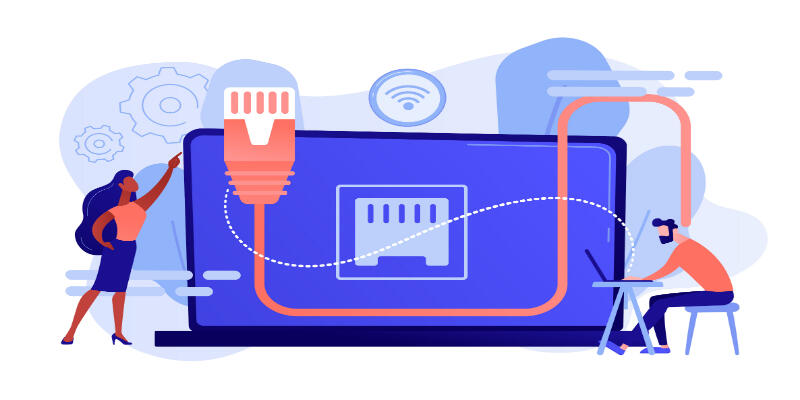Disclaimer: This post may contain affiliate links, meaning we get a small commission if you make a purchase through our links, at no cost to you. For more information, please visit our Disclaimer Page.
With ethernet cables, we always want them to be high quality and to do their job. Internet speed is crucial for everyone, and a wired network is a solution. Therefore, it is best to follow the advice of experts on which Ethernet cable to take and which type and length are sufficient.
An ethernet cable does not reduce speed. The maximum length of the cable is 328 ft, so the cable length cannot cause significant delays. However, if you use a cable that is longer than 328 ft, your network will be weak and will reduce the overall reliability and speed of your network connection.
You have come to the right place to learn more about the length of Ethernet cable and how it affects speed.
Table of Contents
Does the Length of the Ethernet Cable Matter?
When we are setting up internet-connected devices in the house, we do not think much about it. The most important thing for us is to get a cable and plug it into the port.
To be honest, most of us do not worry about the length of the cable, only about whether it works or not.
Ethernet connection is important for our internet connection. Choosing the right cable is a priority, but sometimes we do not know which length to choose and whether it matters at all.
When you look at Ethernet cables, you see that they have CAT labels on them and a number. The CAT indicates its category, and a number shows the specification version cable uses.
A higher number may mean a cable supports faster speed. It enables Ethernet cable to support faster connections.
However, the length of the cable does not really matter. It will not affect network speed significantly, especially modern Ethernet cables.
Of course, that does not mean you should get a cable that goes across the entire house and expect it to work impeccably.
There is a limit to the length of the cable. Although there is no defined limit on how long a cable should be, there are optimal length recommendations. Longer cables usually cause a reduction in latency.
This distance is because of the distance a signal has to travel within the cable. The greater the travel distance, the more likely interference will occur.
Ethernet cables reach up to 328 ft. If they go over, it will hardly affect your connection, since some cables can reach more than 328 ft with no problems. This usually depends on the type of cable you use and the maximum bandwidth it supports.
You will notice no difference in speed if you run a Cat 5 or Cat 6 cable for less than 328 ft. The speed can drop to 10-15 Mbps if you increase the length of a cable to more than 328 ft.
Because of that, anything less than 328 to 360 ft will not affect your speed. If you go over larger distances, you will experience high latency and slower connection.
How Long Can an Ethernet Cable Be Without Losing Speed?
A single Ethernet cable has a maximum distance capacity, which means it has a maximum length it can travel before the signal loss occurs (called attenuation). This issue arises because the electrical resistance of a very long cable affects performance.
Both ends of the cable should be close enough to receive signals quickly while also being far enough away from external electrical interference to avoid interruptions.
However, this precaution does not limit the size of the network because a router or hub can connect multiple Ethernet cables in the same network.
The maximum length of a single CAT5 cable before attenuation is 328 ft. CAT6 can reach the same maximum of 328 ft. Although you can make Ethernet cables longer, they can suffer from signal loss, especially if they pass through large electrical devices.
The length of the Ethernet cable varies depending on whether it is a thin Ethernet cable known as “10BASE2” or a thick Ethernet cable known as “10BASE5”.
The first type of cable should have a maximum length of 597 ft, while the second type can have a maximum length of 164 ft.
However, I suggest you stick to the maximum length standard Ethernet cable can reach—328 ft. Over longer distances, electrical distances degrade. The longer the cable is, the slower your speed becomes.
If you need a longer run, you can extend your cable with an active component, such as a router, in-between the signals. Although you cannot exceed the 328 ft limit, you can place a network switch to extend the overall reach.
As long as the cable from the router to switch and from switch to your device is less than 328 ft long, your device and the router will still be able to communicate
There are sprawling campuses that sometimes use fiber optics to go around the limits of Ethernet cable. Fiber is cheaper than other equipment that is necessary to do the job with copper.
Fiber is overkill if you are wiring your house. That is why CAT5e or CAT6 cables are more than enough when it comes to length.
If you need to extend an Ethernet connection beyond 328 ft, I recommend you invest in a basic network switch. It is a device that gives you additional Ethernet connections to your network.
They switch packets to receive and forward data to your end device. It will do the job well and is not expensive to buy.
Do Multiple Ethernet Cables Reduce Speed?
Your modems usually have four Ethernet ports. Depending on a modem, some ports may be for IP/TV, and sometimes you can use all four for the Internet.
However, if your modem has one port dedicated to the Internet, you will need a switch or a router. Internet providers give you combined devices that have a small router built-in.
They usually have four ports, and you can connect up to 4 devices. You can easily buy one router if there is not one that is built in.
If you connect more than one Ethernet cable, it may reduce the speed of each. But, your internet connection can limit their speed, not the switches themselves.
More cables mean more inconvenience and complicated setup, especially if you have some additional cables from before.
For modern devices, manufacturers trim their ports. In that case, you need to use an Ethernet switch or Ethernet splitter to connect multiple Ethernet cables.
You probably wonder whether these switches and multiple cables reduce speed. It depends on the type of network where you use a splitter.
Ethernet splitters are based on Fast Ethernet, and they carry a traffic rate of 100 Mbps. For instance, the Cat5E Ethernet cable has four pairs of wires, which means there are eight wires in one cable.
Only two of the four Fast Ethernet pairs are in use, and the other not. The splitter will use two 100 Mbps signals from a router. It means two Ethernet cables on one end.
Another solution is an Ethernet cable sharing kit. It carries two Ethernet connections across a single wire. It includes two splitter devices and gives you fast connectivity for more devices with only one cable.
Using the RJ45 coupler is the cheapest way to join more Ethernet cables. It is a small plastic device that has two jacks at each end. Moreover, it does not affect the speed of your Internet connection.
Conclusion
To get the most out of your Ethernet cable, always follow the instructions. There is no way to say at which length your Ethernet cable will experience problems.
Because of that, it is better to stick to those 328 ft to be safe. However, if you still want to expand your cable, use some solutions mentioned above.


